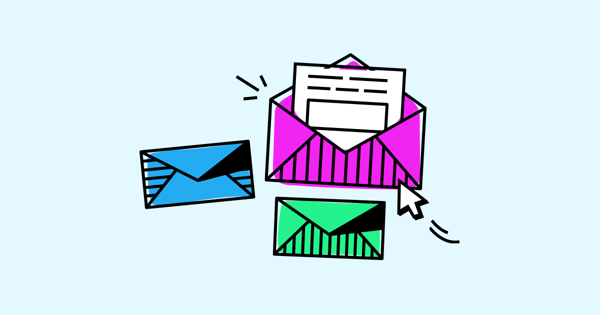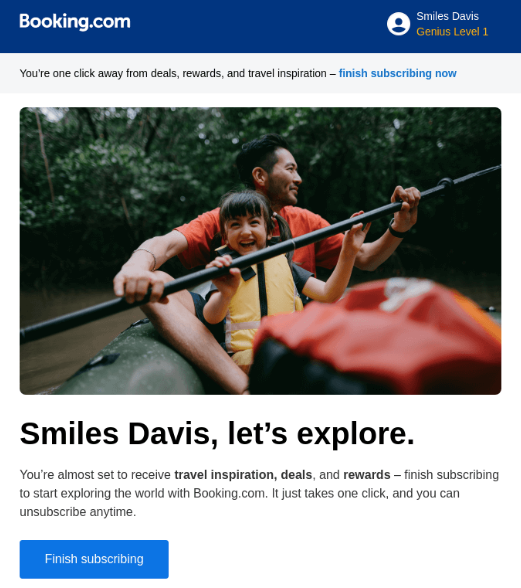Think about all the work that goes into sending a marketing email.
Brainstorming ideas. Working on the design. Writing the body copy. Coming up with a snappy subject line.
So it’s a little depressing to think that the majority of email newsletters will never be opened.
That’s right: Whether they land in the spam or promotions folders, or just stay languishing, unread, in the main inbox, most emails you send will never contribute to your marketing goals.
With that in mind, in this article I’m going to share 10 of my favorite tactics to improve your email open rates.
But let’s start with some fundamentals…

How to Improve Email Marketing Open Rates
What Are Email Marketing Open Rates?
Email open rates show the percentage of your audience who open your emails.
That makes them one of the most important ways to measure the success of your email marketing strategy. Because if no one’s opening your newsletters and promotional emails, something’s clearly going wrong.
On a simple level, a high email open rate is a decent indication that you’re writing strong, compelling subject lines.
But, as we’ll discuss throughout this article, subject lines aren’t the only factor. Email open rates can be affected by everything from your email cadence and timings to your segmentation strategy.
How to Calculate Email Marketing Open Rates
To calculate average open rates for email marketing campaigns, use the following formula:
Email open rate = Number of emails opened / (Number of emails sent – Number of bounced emails) × 100
So let’s say you send 1,000 emails. Of those, 50 end up bouncing and 190 are opened. Now, let’s crunch the numbers to figure out your email open rate:
- 1,000 emails sent – 50 bounced emails = 950 emails delivered
- 190 emails opened / 950 delivered emails = 0.2
- 0.2 x 100 = 20 percent email open rate
Of course, that number alone doesn’t tell us much. To add some much-needed context, let’s take a look at some benchmarks…
Email Marketing Average Open Rates: How Do You Measure Up?
Research shows that the average email open rate stands at 19.66 percent.
So for every five emails you send, on average only one of them will be opened.
Obviously there’s a ton of variance across industries, from 30.85 percent for non-profits, to just 14.97 percent for businesses in the internet marketing niche.
Open rates vary by country too, from a low of 11.21 percent in Singapore, to an astonishing high of 38.33 percent in France.
And they also fluctuate throughout the year, climbing in the run-up to the holiday season, and dropping in January and during the summer months.
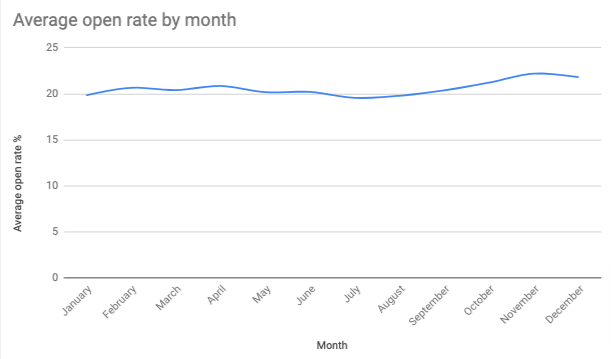 So if you’re a French non-profit that only sends emails in November, you’re probably absolutely delighted with your open rates.
So if you’re a French non-profit that only sends emails in November, you’re probably absolutely delighted with your open rates.
But for everyone else, there’s almost certainly room for improvement.
What Are Good Email Open Rates for Ecommerce?
Average email marketing open rates for ecommerce/retail brands range from 15.68 – 36.59 percent.
Okay, so we know that different industries can see radically different email open rates. So how does the ecommerce niche measure up?
While there’s no single industry-standard figure, different email platforms regularly publish their own benchmarks. We’ve rounded up some of those figures here:
| Platform | Reported average email open rate for ecommerce | Reporting period |
| Campaign Monitor | 17.1 percent* | 2021 |
| Constant Contact | 31.83 percent | April 2023 |
| GetResponse | 31.64 percent* | 2022 |
| Mailchimp | 15.68 percent | October 2019 |
| MailerLite | 36.59 percent | 2022 |
*Reported figures are for “retail” rather than “ecommerce”
That’s a pretty broad variance, huh?
If you’re seeing open rates of ~20 percent, you might be performing way better than your industry peers, or lagging a long way behind them. It all depends on which figures you trust.
In reality, you shouldn’t pay too much attention to industry-wide benchmarks—and you definitely shouldn’t use them to make strategic marketing decisions. Because no other brand is exactly the same as yours.
Instead, operate under the assumption that you can always improve your email open rate.
Here’s how to do it…
10 Tactics to Boost Your Email Open Rate
The higher your open rate, the more people will see your marketing messaging, and the more opportunity you have to sell something.
With that in mind, let’s take a look at 10 strategies to increase your email open rate, with examples from real-world ecommerce brands.
1. Clean Your Email List
A massive email marketing list is only a good thing if your subscribers actually want to hear from you.
Unfortunately, we humans are a fickle bunch.
We might sign up for your email list to claim an offer, open the first couple messages you send, then ghost you forever.
According to Marketo, one-quarter of “average” marketers believe that 26 – 50 percent of their email list is made up of inactive (i.e. disengaged) subscribers.
Surprisingly, top-performing email marketers are even more cynical, with just under one in four saying their inactive rate ranges from 51—75 percent.
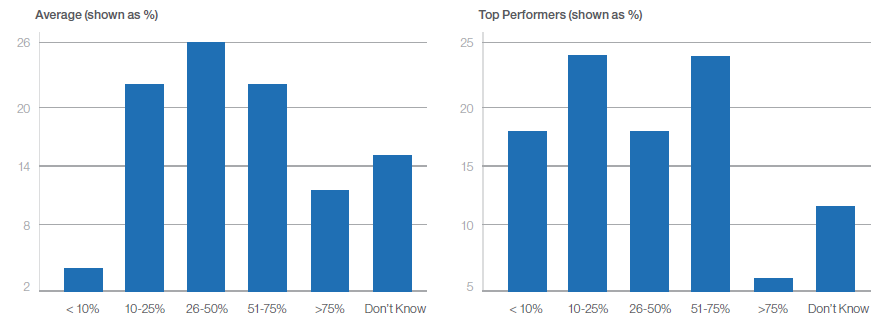 Just think about that for a second.
Just think about that for a second.
Inactive subscribers are people who literally never open or read your emails, but just haven’t bothered unsubscribing from your email list yet.
In short, they’ve emotionally checked out from everything you have to say.
If three-quarters of your email list is inactive, every active subscriber on your list has to open every single email you send, just to achieve an average open rate of 25 percent.
Clearly, this is a big problem for email marketers.
If you have a ton of disengaged email subscribers who aren’t interested in anything you have to say, you’re inevitably going to end up with low open rates.
So what can you do about it?
One simple solution is to regularly clean your email list by purging contacts who are inactive, outdated, or simply don’t want to receive your newsletters anymore. That way, you can feel pretty confident you’re only sending to people who are interested in your brand and products.
The first step to freshening up your marketing list is to deal with basic issues, such as:
- Correcting typos in your email data (like “@gmial.com”)
- Scrubbing any hard-bounced email addresses
- Removing contacts who return repeated soft bounces (say, 3+)
- Merging duplicate contacts
Having dealt with the fundamentals, you can move onto the more advanced stuff…
2. Use Double Opt-Ins for New Subscribers
Ecommerce leads are valuable. So when you capture a new email address, it makes sense to start targeting the contact with promotions and product recommendations as soon as possible, right?
Not necessarily.
While most ecommerce email marketing strategies are based around a single opt-in, some brands prefer the double opt-in approach—a two-step process where the lead:
- Enters their email address in an onsite signup form
- Receives a confirmation email that instructs them to click a link to join the email list
Here’s an example of a double opt-in confirmation email from Booking.com:
I like how this email builds anticipation with the promise of travel inspiration, deals, and rewards—and all you have to do is complete the subscription process by clicking that big blue button.
Still, the drawbacks of double opt-ins are obvious. Adding another step to the signup process makes it harder to grow your marketing list fast.
But on the plus side, double opt-ins make it far less likely that disinterested contacts will end up on your list, which means you’re likely to enjoy higher open rates going forward.
3. Re-Engage Inactive Email Subscribers
We’ve discussed using double opt-ins to give yourself the best chance of sending to engaged subscribers.
Now let’s tackle what to do with contacts who simply refuse to open your emails: target them with a re-engagement campaign.
Your prime objective here is to encourage people to interact with your emails, although there could also be a secondary goal: persuading people who have no intention of interacting to unsubscribe from your marketing list.
That way, your list might shrink, but more of your remaining subscribers will be engaged—so your open rates will increase.
Plus-size fashion brand Torrid does this by reaching out to inactive subscribers with a targeted offer:
 Clearly, Torrid hopes that those inactive subscribers will be tempted to find out what the offer entails—which means opening the email.
Clearly, Torrid hopes that those inactive subscribers will be tempted to find out what the offer entails—which means opening the email.
Whether or not they take advantage of the promotion, it’s a step in the right direction, because they’re finally engaging with Torrid’s content.
4. Ask Subscribers to Whitelist Your Emails
No brand intends to send spam emails.
Why would they?
Consumers are smart, so even if a spammy email makes it as far as a subscriber’s main inbox, they’re highly unlikely to open it.
Yet according to Return Path’s latest Email Deliverability Benchmark Report, eight percent of all commercial emails in the US end up in the spam folder:
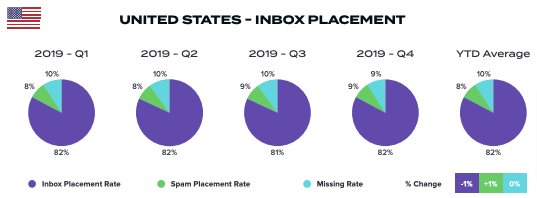 Again, that’s a big issue for brands.
Again, that’s a big issue for brands.
If your email lands in spam, no one’s going to see it, let alone open it.
So you might as well not have sent it.
There are a whole lot of reasons why emails go to spam.
But the good news is that there are practical steps you can take to stop it from happening.
One of the simplest and most effective tactics is to ask subscribers to “whitelist” your email address.
Whitelisting means adding an email address to an approved list of senders, so that any emails you receive from that address will never be sent to the spam folder.
The Kewl Shop understands the value of whitelisting.
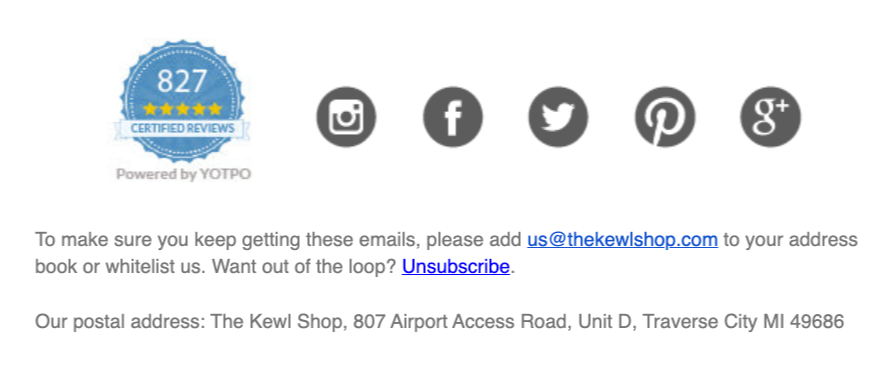 In its email footer section, it urges subscribers to add its address to their address books or whitelists.
In its email footer section, it urges subscribers to add its address to their address books or whitelists.
Another smart move is to use this tactic in your welcome emails.
That way, you’re encouraging people to whitelist your address from the first moment you reach out to them, ensuring they never miss a message from you.
5. Perfect Your Subject Lines
By this point, I’ve discussed the importance of re-engaging inactive subscribers from your marketing list and improving email deliverability through whitelisting.
Those steps should position you to reach as many active subscribers as possible.
But that still doesn’t mean you’re guaranteed to enjoy sky-high open rates.
Even active subscribers will be turned off by emails that don’t attract their attention and compel them to click.
Once your messages hit the main inbox, the email subject line is your best tool for driving open rates.
Research shows that almost half of respondents decide to open an email based on the subject line alone, while two-thirds report email as spam based solely on the subject line.
Okay, so subject lines are important.
But you already knew that, right?
So what does an engaging email subject line look like?
Well, Yesware has carried out various (huge) studies on the components of a perfect subject line.
Among other things, it found that:
- Subject lines that include numbers get a 45 percent higher open rate than the average open rate.
- The most successful emails based on open and reply rates had subject lines of between 1 – 5 words.
- Subject lines phrased as questions see open rates that are about 10 percent higher than non-question subject lines.
Ultimately, there’s no such thing as the perfect subject line; it all depends on your brand, tone of voice, and audience.
To demonstrate, let’s take a look at two subject lines from brands in the cosmetics niche.
First up is Charlotte Tilbury, whose brand is pretty much inseparable from its eponymous founder. Its emails are often written in the first person, as if they were sent by Charlotte herself—hence subject lines like this:
![]() It’s chatty, it includes eye-catching elements like an emoji and all-caps text, and it uses first-person language.
It’s chatty, it includes eye-catching elements like an emoji and all-caps text, and it uses first-person language.
Bobbi Brown, on the other hand, is more about the company than the makeup artist behind it (a quick scan of our swipe file didn’t flag up any emails written “from Bobbi”). Here’s a recent subject line:
![]() Compared to Charlotte Tilbury, the tone feels more formal, and it’s geared toward giving advice rather than highlighting individual products.
Compared to Charlotte Tilbury, the tone feels more formal, and it’s geared toward giving advice rather than highlighting individual products.
They’re both founder-run brands, and they’re in the same niche, yet their subject lines are totally different.
Which just goes to show that the only way to improve your email subject lines is to understand what works for you. Use A/B testing to figure out the types of subject line messaging and tone of voice that resonate best with your audience—then do more of it.
6. Personalize Subject Lines (Where You Can)
Personalization is another key factor to subject line effectiveness.
Consumers open emails with personalized subject lines at a 50 percent higher rate than emails without personalized subject lines.
Yet bafflingly, only two percent of emails use subject line personalization.
Personalization needn’t be too complex.
It could simply involve mentioning your subscribers by name, like AllSaints does here:
 This sort of basic personalization can be surprisingly effective, with research showing that adding a first name to your subject line can boost open rates by 16.5 percent.
This sort of basic personalization can be surprisingly effective, with research showing that adding a first name to your subject line can boost open rates by 16.5 percent.
Or, to get a little more sophisticated, you can follow Bellroy’s lead by making it clear that your email contains personalized product recommendations:
 This is a smart tactic, with Accenture research revealing that 91 percent of consumers are more likely to shop with brands who recognize them, remember them, and provide them with relevant offers and recommendations.
This is a smart tactic, with Accenture research revealing that 91 percent of consumers are more likely to shop with brands who recognize them, remember them, and provide them with relevant offers and recommendations.
7. Don’t Neglect Preview Text
While subject lines are often the first port of call when it comes to improving email open rates, there’s another important piece of inbox real estate that also plays a key role.
I’m talking about the preview text, also known as the snippet or message preview.
There’s no clear-cut advice on how long your preview text should be, because users can change the appearance within their email client settings. Some will see as much as five lines of text, whereas others will see nothing at all.
But short and sweet is definitely the way to go. Limit your preview text to no more than 90 characters to give your copy the best chance of showing up without truncating.
As with subject lines, there’s no set rule to writing compelling preview text—it all depends on your brand and who you’re targeting.
Still, as a general rule, try to combine your subject line and preview text into a single, cohesive message, just like REBEL8 did in this example:
![]() I also like the intriguing nature of this subject-line-and-preview-text combo. There’s no context to the messaging, which makes you want to click to find out what they’re talking about.
I also like the intriguing nature of this subject-line-and-preview-text combo. There’s no context to the messaging, which makes you want to click to find out what they’re talking about.
8. Segment Your Marketing List
So personalization is one of the most important factors in crafting must-click email subject lines.
But you can’t “do” personalization without effective email segmentation—that is, cutting and slicing your email list to build segments made up of people with shared characteristics, preferences, and/or behaviors.
Segmentation is extremely effective at boosting open rates.
According to one study, segmented email campaigns see 14 percent higher open rates than non-segmented campaigns.
Not only that, but they achieve 11 percent more unique opens and 101 percent more clicks.
There are any number of ways to segment your marketing list, such as:
- By demographics, such as age, gender, and location
- By the source or channel from which they subscribed to your email list
- By which pages they visit on your website
- By whether they’ve recently abandoned their shopping carts
- By purchase history
- By purchase amount and average order value
- By the types of products they’ve viewed or “favorited”
Apparel brand Kina and Tam uses the last of those techniques to reach out to customers who’ve previously shown interest with products in its “day polo” category:
 It’s not hard to figure out why this is effective.
It’s not hard to figure out why this is effective.
If I’ve been browsing a bunch of day polos and a brand reaches out to me with a selection of similar products, there’s a good chance I’m going to open that email.
9. Get Your Email Timings Right
Unsurprisingly, timing is another key factor in boosting email open rates.
If, for some unfathomable reason, you decide to schedule your next campaign to send at 3am local time, don’t expect a lot of opens.
By the time the majority of your subscribers have woken up, your early bird email will be well and truly lost in the depths of their inboxes.
That’s an extremely simple example; I’d like to think most marketers already understand that it’s best practice to send emails at a time when recipients are likely to be awake.
But there’s a whole lot of data (and disagreement) on the best time and day to send marketing emails.
For what it’s worth, our own data shows that we see vastly more email traffic to our website on Thursdays than any other day:
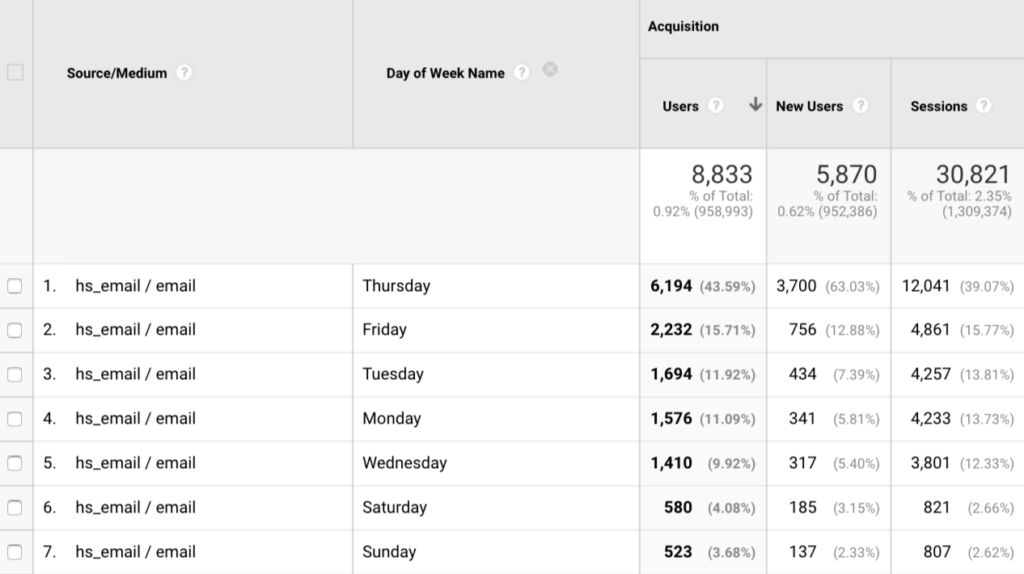 Meanwhile, Sendinblue’s data found that the best time slot for sending ecommerce marketing emails is at 10am on Tuesdays and Thursdays.
Meanwhile, Sendinblue’s data found that the best time slot for sending ecommerce marketing emails is at 10am on Tuesdays and Thursdays.
Realistically, you can only learn so much by relying on other people’s data.
Fact is, no other brand has an audience that’s identical to yours, so what works for one company might not work for you.
For that reason, the only way to definitively find the best time to send marketing emails is to test, test, and test some more.
Try splitting your email list in half and sending the same email to both segments at different times.
With enough testing, you should be able to identify the specific day and time when subscribers are most likely to engage with your emails.
10. Don’t Overdo the Cadence
Your email cadence is the frequency and timing of your email campaigns.
As an email marketer, your goal is to optimize your cadence, finding the perfect combination of send time and email volume to maximize open rates, click-throughs, and sales.
When it comes to crafting the perfect email cadence, less is often more.
Send emails too frequently and you risk annoying your subscribers and harming your engagement.
While there’s plenty of advice about the best time to send emails (and how many you should send in a given day, week, or month), your best bet is to trust your own data.
Experiment with different cadences until you find the volume and timings that deliver the highest open rates.

Increase Email Open Rates With Drip
There are some basic steps you can take to boost email open rates, like removing bounced contacts from your marketing list and fixing typos.
Once you’ve done the simple stuff, it’s mostly a case of sending the right emails to the right people at the right time.
Sounds easy—but without the right tools, it’s near-impossible.
That’s why you need Drip in your corner. Our platform makes it simple to build smart customer segments that update in real time, helping you deliver ultra-personalized messaging that keeps people engaged with your brand.
Want to target loyal customers who’ve spent $200+ in the last three months? Re-engage lapsed email subscribers? Or win back cart abandoners before they buy from someone else? Do it all—and much more besides—with Drip.
Find out for yourself by signing up for your free 14-day trial.
